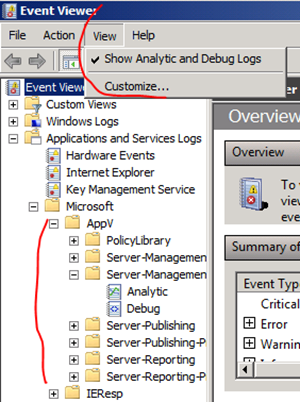How to collect App-V 5.0 debug traces
 Hi all! This is Vladimir from the App-V team and today I want to show you how to collect App-V 5.0 server ETL traces. These ETL traces can be helpful in certain troubleshooting scenarios and the steps below show you how to collect them from the App-V 5.0 Management, Publishing and Reporting servers.
Hi all! This is Vladimir from the App-V team and today I want to show you how to collect App-V 5.0 server ETL traces. These ETL traces can be helpful in certain troubleshooting scenarios and the steps below show you how to collect them from the App-V 5.0 Management, Publishing and Reporting servers.
1. First we need to register what kind of ETL traces we want to collect. There are 7 different ETL streams available and to collect them all in the same trace we can type the following at an elevated command prompt on the App-V 5.0 Management/Publishing/Reporting server:
Logman create trace APPV5 -p Microsoft-AppV-PolicyLibrary -o appv.etl
Logman update trace APPV5 -p Microsoft-AppV-Server-Management
Logman update trace APPV5 -p Microsoft-AppV-Server-Management-Private
Logman update trace APPV5 -p Microsoft-AppV-Server-Publishing
Logman update trace APPV5 -p Microsoft-AppV-Server-Publishing-Private
Logman update trace APPV5 -p Microsoft-AppV-Server-Reporting
Logman update trace APPV5 -p Microsoft-AppV-Server-Reporting-Private
2. We then need to start the trace by running the following command:
Logman start APPV5
3. Now reproduce the issue.
4. Once the issue is reproduced, we need to stop the trace using this command:
Logman stop APPV5
5. Next we need to find out where the ETL file was created by using this command:
Logman query APPV5| find /I "ETL"
6. Finally, we can convert the ETL file into a TXT file using the following:
Netsh trace convert APPV_<RANDOM>.ETL
An example of this is below:
Note that you can also view more detailed App-V 5.0 server event logs by checking “Show Analytic and Debug Log” in the Event Viewer:
I hope that you found this information useful. See you soon!
Vladimir Petrosyan | Support Escalation Engineer | Management and Security Division
Get the latest System Center news on Facebook and Twitter :
System Center All Up: https://blogs.technet.com/b/systemcenter/
System Center – Configuration Manager Support Team blog: https://blogs.technet.com/configurationmgr/
System Center – Data Protection Manager Team blog: https://blogs.technet.com/dpm/
System Center – Orchestrator Support Team blog: https://blogs.technet.com/b/orchestrator/
System Center – Operations Manager Team blog: https://blogs.technet.com/momteam/
System Center – Service Manager Team blog: https://blogs.technet.com/b/servicemanager
System Center – Virtual Machine Manager Team blog: https://blogs.technet.com/scvmm
Windows Intune: https://blogs.technet.com/b/windowsintune/
WSUS Support Team blog: https://blogs.technet.com/sus/
The AD RMS blog: https://blogs.technet.com/b/rmssupp/
App-V Team blog: https://blogs.technet.com/appv/
MED-V Team blog: https://blogs.technet.com/medv/
Server App-V Team blog: https://blogs.technet.com/b/serverappv
The Forefront Endpoint Protection blog : https://blogs.technet.com/b/clientsecurity/
The Forefront Identity Manager blog : https://blogs.msdn.com/b/ms-identity-support/
The Forefront TMG blog: https://blogs.technet.com/b/isablog/
The Forefront UAG blog: https://blogs.technet.com/b/edgeaccessblog/
Comments
Anonymous
February 12, 2013
Error 2/12/2013 1:14:35 PM Client 19104 Publishing Refresh Part or all packages publish failed. published: 15 failed: 1 Please check the error events of 'Configure/Publish Package' before this message for the details of the failure. Information 2/12/2013 1:14:35 PM Client 1002 Configure Package Package {138cb424-eb10-4c5f-9821-7e531d432eb9} version {da4539d1-ccd7-4d53-8c90-5ba4ce7d62b6} was successfully configured in folder 'C:ProgramDataApp-V138CB424-EB10-4C5F-9821-7E531D432EB9DA4539D1-CCD7-4D53-8C90-5BA4CE7D62B6'. Where to begin. A reboot doesn't solve it, the folders are so locked down I can't delete them (I get "you mus have permission from <userx>" where <userx> is the user I'm logged in as, I can't get the files unlocked to save my life, and the error message is effectively "this failed, see the message" and the message says "this succeeded!" Bad, bad, bad form...that plus not being able to refresh without a logoff/service restart (can I ask you, why do you have a powershell cmdlet to sync the publishing server if it doesn't work, yet you couch the functionality as almost intentional, and did you test this...at all...before releasing it? Because surely running that cmdlet one single time would have shown anyone that it was pointless and doesn't work). I predicted MDOP 2012 would be out in spring of 2013 and so far from what I'm seeing, maybe a finished version actually will be. This is again you taking our money for a product that isn't done, and isn't ready for enterprise yet, it carries WAY too many risks and costs way too much to support. What it fixes over 4.6 (and that list is long indeed) it mitigates to a great extent by just...dealbreaking stupidity. Why on earth would you ship this cmdlets to refresh, a gui that lets you refresh, and neither of them actually work. Does that seem "done" to you? Or is releasing broken software you take money for without any real and meaningful competition still your idea of a choice between "perfect" and "in time to be relevant"... I guess I should be saying thank you, I'm paid pretty well to do literally nothing but fix your bad software all day, think of what I could be paid to do if it worked...Anonymous
February 16, 2014
Yes, there is a learning curve with the new release of App-V. This is why it is extremely important that




